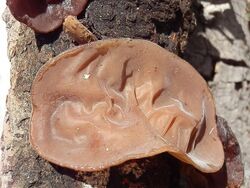Biology:Auricularia americana
| Auricularia americana | |
|---|---|

| |
| Auricularia americana on dead conifer wood, Arizona | |
| Scientific classification | |
| Domain: | Eukaryota |
| Kingdom: | Fungi |
| Division: | Basidiomycota |
| Class: | Agaricomycetes |
| Order: | Auriculariales |
| Family: | Auriculariaceae |
| Genus: | Auricularia |
| Species: | A. americana
|
| Binomial name | |
| Auricularia americana Parm. & I.Parm. ex Audet, Boulet & Sirard (2003)
| |
Auricularia americana is a species of fungus in the family Auriculariaceae. Basidiocarps (fruitbodies} are gelatinous, ear-like, and grow on dead conifer wood. The species was formerly confused with Auricularia auricula-judae, which grows on broadleaf wood and is confined to Europe.
Taxonomy
The species was originally described in 1987 from Quebec on Abies balsamea, but was not validly published until 2003. Molecular research, based on cladistic analysis of DNA sequences, has shown that Auricularia americana is a distinct species.[1][2]
Description
Auricularia americana forms thin, brown, rubbery-gelatinous fruit bodies that are ear-shaped and up to 100 mm (3.9 in) across and 3 mm (0.12 in) thick. The fruitbodies occur singly or in clusters. The upper surface is finely pilose. The spore-bearing underside is smooth.[2]
Microscopic characters
The microscopic characters are typical of the genus Auricularia. The basidia are tubular, laterally septate, 55–70 × 4–5 µm. The spores are allantoid (sausage-shaped), 14–16.5 × 4.5–5.5 µm.[2]
Habitat and distribution
Auricularia americana is a wood-rotting species, typically found on dead attached or fallen wood of conifers. It is widely distributed in North America and is also known from China and the Russian Far East.[2]
Similar species
In North America, Auricularia angiospermarum is almost identical but grows on the wood of broadleaf trees. No other North American Auricularia species grows on conifer wood. In China and Tibet, however, a second species, Auricularia tibetica, also occurs on conifers. It can be distinguished microscopically by its longer basidia and larger basidiospores.[1][2]
References
- ↑ 1.0 1.1 "Global diversity and taxonomy of the Auricularia auricula-judae complex (Auriculariales, Basidiomycota)". Mycological Progress 14 (10). 2015. doi:10.1007/s11557-015-1113-4.
- ↑ 2.0 2.1 2.2 2.3 2.4 "Global diversity and updated phylogeny of Auricularia (Auriculariales, Basidiomycota)". Journal of Fungi 7 (11): 933. 2021. doi:10.3390/jof7110933. PMID 34829220.
Wikidata ☰ Q10422714 entry
 |

